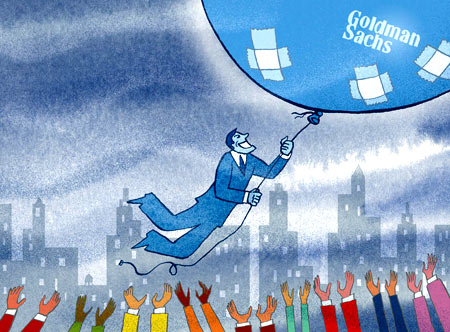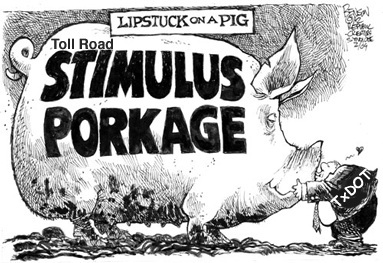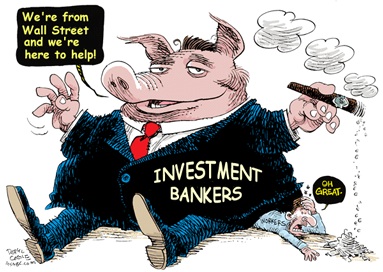“Everything—including the flagship Macquarie Infrastructure Group—is now up for grabs.”
Ailing operator denies talk that it might sell its stake
8/1/09
Peter Schnitzler
Indiana Business Journal
Copyright 2009
Gov. Mitch Daniels expected his unprecedented $3.8 billion Indiana Toll Road lease to last 75 years. It may be tested after just three.
The foreign companies that privatized the property haven’t escaped the global economic downturn. As a result, the value of their investments has plummeted. Now, as they labor to shed enormous debt loads, analysts and the financial media are abuzz that the Indiana Toll Road lease could change hands.
In June 2006, Indiana struck a deal with Australia-based Macquarie Group Ltd. and Spain-based Cintra Concesiones de Infraestructuras de Transporte SA. Indiana got $3.8 billion upfront, money it’s used across the state to fund the Major Moves highway improvement initiative.
In exchange, the investors bought the right to collect tolls, with the obligation they manage, maintain and upgrade the road.
If the companies sell the lease, the new owners would take over that duty. Or if Macquarie and Cintra retain the lease but fail to live up to its terms, Indiana gets its toll road back.
The outlook for the state of Indiana might be least favorable under the status quo. That’s because the companies could try to dig themselves out of their financial hole by continuing to aggressively raise tolls.
Getting the road back, on the other hand, wouldn’t necessarily be an unfavorable turn of events for the state. Indiana would be on the hook for future improvements, but also would receive the toll revenue—which totaled $155 million last year.
Retaining ownership might be the most appealing option for Macquarie and Cintra, since any sale likely would reap a fraction of what they paid. Recent write-downs by Macquarie suggest the same lease deal today could fetch as little as $445 million.
Both companies have been exiting investments across the globe to reduce debt, and some Australian stock analysts say Macquarie is likely to do the same with its stake in the Indiana Toll Road, since vehicle traffic hasn’t met expectations.
Macquarie flatly denies that possibility.
“[Macquarie] is not in the market pursuing a sales process for any of its U.S. assets, including the Indiana Toll Road,” wrote Macquarie spokesman Alex Doughty in an e-mail. “Speculation suggesting otherwise is simply incorrect.”
The private operators, who thought they bought a cash cow, have already proven aggressive in hiking tolls. With so much invested, the companies have an incentive to milk the lease, taking advantage of language in the agreement that could permit annual toll increases of 5 percent or higher.
That’s exactly what House Speaker Pat Bauer, D-South Bend, an outspoken critic of the Indiana Toll Road lease, feared from the start.
“It was never meant to be a profit center or to make money,” he said of the highway, which opened in the mid-1950s. “It was meant to be low tolls for maintenance and, eventually, a free road.”
Unbreakable lease?
The Indiana Toll Road lease is hundreds of pages long, all legal screed. It details the operators’ duties and every other obligation a legal team led by locally based Ice Miller LLP and Chicago-based Mayer Brown LLP could negotiate. State officials consider it unbreakable. And they say it anticipates every conceivable risk, including operator bankruptcy.
“No question there are financial challenges out there for both [Macquarie and Cintra]. But that’s the nature of the economy,” said Leigh Morris, the Indiana Department of Transportation’s deputy commissioner for toll road oversight. “I have every confidence this is not going to turn out to be a problem for the state of Indiana.”
The lease mandates $4.5 billion in improvements over its seven-and-a-half decades. The companies already have made good on $191 million worth of upgrades, mainly by adding electronic tolling and widening congested stretches of the road. Another $157 million in projects are scheduled by the end of 2010.
The partnership is funding improvements through a $660 million bank loan, which Cintra spokesman Patrick Rhode said is scheduled to remain in place until 2014.
“The Indiana Toll Road is a long-term lease and during that term there will be peaks and valleys,” Rhode wrote via e-mail in response to IBJ’s questions.
“This is a valley, but the economy will recover and in the future we will be talking about the ITR and its performance peaks, not the valleys.”
Analysts’ main concern today is that weak tolling traffic could drain cash reserves used for debt service on the bank loan before 2014.
In a June 2009 report on the state of U.S. toll roads, Moody’s Investors Service gave the industry a negative outlook for the next year to 18 months, noting weak economic conditions have flattened traffic growth. On July 17, Macquarie reported revenue fell 5.1 percent on three of its four U.S. toll roads last year. The company also holds stakes in Chicago’s Skyway and Virginia’s Dulles Greenway. The exception was the South Bay Expressway in San Diego. Its traffic fell just 2.3 percent.
“For the most part, toll roads have demonstrated pricing power and financial stability through aggressive toll increases, or the reduction or elimination of discounts,” according to Moody’s report. “Careful budgetary management, the deferral of some capital projects, and lower construction costs have allowed most toll roads to maintain solid cash flows and credit metrics.”
The report adds: “We are concerned that accelerated traffic declines and toll increases (needed to support increased debt issuance) could soften financial ratios and cause more ratings downgrades.”
But Ian Myles, an equity analyst for Macquarie Securities—a unit of the Australian financial giant—downplayed the possibility of an Indiana Toll Road cash crunch.
“ITR has significant cash reserves. The purpose of those reserves is to ensure they meet their debt obligations during periods of weak traffic,” he said in an e-mail from Australia.
“Whilst they may never have forecast the extent of the weakness, there is significant cash on the balance sheet to meet the interest obligations. We estimate reserves of $110 [million]. … We do not believe the road is at risk of default.”
Unwinding portfolios
The Indiana Toll Road is just one of many infrastructure properties Macquarie and Cintra hold stakes in around the world, acquired in deals mostly funded with debt.
In the recession, both companies became over-leveraged and now are unwinding their portfolios. One of the Macquarie properties on the block is downtown’s Chase Tower, the state’s tallest building. The company listed it in January, with an asking price of $180 million.
“No matter how you look at it, Macquarie Group is in the process of unraveling itself from the tangled web of funds that once catapulted its executives into the salary stratosphere but now shackle every attempt to resurrect its tarnished image,” Ian Verrender, a columnist for the Sydney Morning Herald, wrote in June.
“Everything—including the flagship Macquarie Infrastructure Group—is now up for grabs.”
On July 17, Macquarie subsidiary Macquarie CountryWide Trust agreed to sell its 75-percent interest in 86 U.S. grocery-anchored shopping malls for $1.3 billion. Macquarie Communications Infrastructure Group is nearing completion of a $1.3 billion takeover by the Canada Pension Plan Investment Board.
Cintra has had its own problems. A March 24 analyst’s report by Credit Suisse called the Indiana Toll Road “Cintra’s most risky major asset,” pointing out disappointing traffic has led the company to curtail dividends. It also says refinancing Indiana Toll Road’s debt will be tough.
On July 27, Cintra sold its parking lot division for $634 million. The next day, Bloomberg News reported that Macquarie may sell its leases on the Chicago Skyway and Indiana Toll Road to raise cash.
But if either Cintra or Macquarie sold now, they would be locking in huge losses. Macquarie subsidiary Macquarie Infrastructure Group has written down its stake repeatedly in the past year, most recently in July. The valuation for its stake is 61-percent less than it was a year ago and suggests the entire lease may be worth just $445 million on the open market.
If either Macquarie or Cintra decided to sell their stakes, they’d need the state’s approval, said Ryan Kitchell, director of Indiana’s Office of Management and Budget.
Enforcing the lease
Before the deal, Indiana had been spending about $35 million annually on maintenance, INDOT’s Morris said. If the state got the road back, it would be on the hook for the billions of dollars in improvements the private partnership promised to make over the life of the lease.
But Indiana already has its $3.8 billion, noted University of Indianapolis finance professor Matt Will. If it repossessed the toll road, it might even be able to enter a fresh lease with somebody else, creating another payday.
“This is why it was such a genius deal, because of the upfront payment,” Will said. “It’s a no-lose situation for the state.”
For the state, the biggest challenge could be ensuring the current leaseholders live up to all aspects of their agreement despite their financial problems.
There’s a lot of middle ground between failure to meet the standards of one of the lease’s sub-clauses and complete default. INDOT’s Morris said the contract lays out a series of steps on the way to repossessing the road if the partnership fails to keep it up properly, each requiring 90 days’ notice. So far, he said, the companies have been in complete compliance.
“They have met every obligation they assumed under the lease,” Morris said. “They have been very good business partners.”
But Hoosiers, long used to low tolls, still are getting used to having the Indiana Toll Road run with a business mindset. In 2005, the year before the lease, state records show the Indiana Toll Road generated $96 million in revenue, almost entirely from tolls. By 2008, the private partnership had boosted the road’s revenue 62 percent, to $155 million.
From 1985 to 2006, the state kept the price for driving a car with two axles across the Indiana Toll Road’s 157 miles constant at $4.65. Today, the toll is $8 for the trip. And the price is far higher for larger vehicles. A truck with seven axles pays $69.75.
Those prices will rise. The lease allows operators, starting in 2011, to hike tolls every year by the percentage increase in the U.S. gross domestic product or by 2 percent, whichever is greater.
Over the last 25 years, U.S. Department of Commerce records show that U.S. GDP has risen an average of 5.7 percent a year. In 1984, when the United States came out of its last deep recession, GDP grew 11.2 percent.
“It is impossible to pinpoint future rates,” wrote Cintra’s Rhode. “But rest assured any adjustment will be within the provided parameters.” •
© 2009 Indiana Business Journal: www.cms.ibj.com
To search TTC News Archives click
To view the Trans-Texas Corridor Blog click












